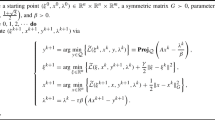Abstract
We show that Tapia's quasi-Newton diagonalized approach to constrained minimization can be formulated in such a way that no linear systems have to be solved of dimension larger than the natural ones or which present singularities. Numerical experiments indicate fast local convergence, but also substantial difficulties of global convergence.
Similar content being viewed by others
References
Tapia, R. A.,Diagonalized Multiplier Methods and Quasi-Newton Methods for Constrained Optimization, Journal of Optimization Theory and Applications, Vol. 22, pp. 135–194, 1977.
Powell, M. J. D.,A Fast Algorithm for Nonlinearly Constrained Optimization Calculations, Cambridge University, Report No. DAMTP-77/2, 1977.
Tapia, R. A.,A Stable Approach to Newton's Method for General Mathematical Programming Problems in R n, Journal of Optimization Theory and Applications, Vol. 14, pp. 453–476, 1974.
Mangasarian, O. L.,Unconstrained Lagrangians in Nonlinear Programming, SIAM Journal on Control, Vol. 13, pp. 772–791, 1974.
Grippo, L., andDi Pillo, G.,An Augmented Lagrangian for Inequality Constraints in Nonlinear Programming Problems, Istituto di Automatica, University of Rome, Report No. 79/22, 1979.
Miele, A., Calabro, A., Rossi, F., andWu, A. K.,A Modification of the Sequential Gradient Restoration Algorithm for Mathematical Programming Problems with Inequality Constraints, Rice University, Aero-Astronautics Report No. 124, 1975.
Miele, A., Calabro, A., Rossi, F., andWu, A. K.,The Prerestorative Step in the Sequential Gradient-Restoration Algorithm for Mathematical Programming Problems with Inequality Constraints, Applied Mathematics and Computation, Vol. 3, pp. 265–280, 1977.
Powell, M. J. D.,The Convergence of Variable Metric Methods for Nonlinearly Constrained Optimization Calculations, Nonlinear Programming 3, Edited by O. Mangasarian, R. Meyer, and S. Robinson, Academic Press, New York, New York, 1978.
Bertocchi, M., Cavalli, E., andSpedicato, E.,Computational Performance of Diagonalized Multiplier Quasi-Newton Methods for Nonlinear Optimization with Equality Constraints, Numerical Optimization of Dynamical Systems, Edited by L. C. W. Dixon and G. P. Szego, North-Holland Publishing Company, Amsterdam, Holland, 1980.
Tapia, R. A.,On the Role of Slack Variables in Quasi-Newton Methods for Constrained Optimization, Numerical Optimization of Dynamical Systems, Edited by L. C. W. Dixon and G. P. Szego, North-Holland Publishing Company, Amsterdam, Holland, 1980.
Author information
Authors and Affiliations
Additional information
Communicated by R. A. Tapia
This work was supported by the National Science Council of Italy in the framework of the SOFTMAT project. Part of the work was done during visits at the Computer Science Department, Stanford University, and at the Numerical Optimization Centre, Hatfield Polytechnic; the author thanks Prof. G. Golub and Prof. L. Dixon for providing a stimulating atmosphere. Thanks are also due to Dr. M. Bertocchi, University of Bergamo, for collaboration in performing the numerical experiments.
Rights and permissions
About this article
Cite this article
Spedicato, E. On a Newton-like method for constrained nonlinear minimization via slack variables. J Optim Theory Appl 36, 175–190 (1982). https://doi.org/10.1007/BF00933828
Issue Date:
DOI: https://doi.org/10.1007/BF00933828




